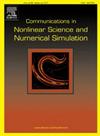空间遍历维数:离散混沌系统中轨迹的遍历自相似性
IF 3.8
2区 数学
Q1 MATHEMATICS, APPLIED
Communications in Nonlinear Science and Numerical Simulation
Pub Date : 2025-02-14
DOI:10.1016/j.cnsns.2025.108671
引用次数: 0
摘要
混沌系统表现出自相似性,这是其内在复杂性的表现。本文发现混沌系统的空间遍历轨迹在不同空间尺度上表现出一致的遍历行为,表现为幂律标度:β(ε)∝ε−d与d>;1。本文引入了一种新的分形维数度量d,称为空间遍历维数(DE),它提供了对离散混沌系统空间遍历轨迹的统计自相似性的定量评估,填补了定性遍历分析的研究空白。DE反映了混沌系统在有限时间内空间运动状态分布的均匀性,表现出尺度不变性。实验结果表明,在不同的混沌系统中,DE是不同的,表明较低的DE对应更均匀的空间遍历轨迹。此外,DE与混沌系统的不变概率测度密切相关。具体而言,具有不同不变概率测度的混沌系统具有不同的DE值,而具有相同不变概率测度的不同混沌系统具有相似的DE值。本文章由计算机程序翻译,如有差异,请以英文原文为准。
Spatial ergodicity dimension: Ergodic self-similarity of trajectories in discrete chaotic systems
Chaotic systems exhibit self-similarity as a manifestation of their inherent complexity. In this paper, it is found that the spatial ergodic trajectories of chaotic systems exhibit consistent traversal behaviors across different spatial scales, manifesting power-law scaling: with . Here, is introduced as a novel metric of fractal dimensions termed the Spatial Ergodicity Dimension (), which provides a quantitative assessment of the statistical self-similarity in the spatial ergodic trajectories of discrete chaotic systems and fills the research gap in qualitative ergodicity analysis. reflects the uniformity of the spatial motion state distribution of chaotic systems over a finite time period, exhibiting scale invariance. Experimental results demonstrate that the varies across chaotic systems, unveiling that a lower corresponds to more even spatial traversal trajectories. Furthermore, the is closely associated with the invariant probability measure of chaotic systems. Specifically, chaotic systems with different invariant probability measures exhibit distinct values, while different chaotic systems with the same invariant probability measure exhibit similar values.
求助全文
通过发布文献求助,成功后即可免费获取论文全文。
去求助
来源期刊

Communications in Nonlinear Science and Numerical Simulation
MATHEMATICS, APPLIED-MATHEMATICS, INTERDISCIPLINARY APPLICATIONS
CiteScore
6.80
自引率
7.70%
发文量
378
审稿时长
78 days
期刊介绍:
The journal publishes original research findings on experimental observation, mathematical modeling, theoretical analysis and numerical simulation, for more accurate description, better prediction or novel application, of nonlinear phenomena in science and engineering. It offers a venue for researchers to make rapid exchange of ideas and techniques in nonlinear science and complexity.
The submission of manuscripts with cross-disciplinary approaches in nonlinear science and complexity is particularly encouraged.
Topics of interest:
Nonlinear differential or delay equations, Lie group analysis and asymptotic methods, Discontinuous systems, Fractals, Fractional calculus and dynamics, Nonlinear effects in quantum mechanics, Nonlinear stochastic processes, Experimental nonlinear science, Time-series and signal analysis, Computational methods and simulations in nonlinear science and engineering, Control of dynamical systems, Synchronization, Lyapunov analysis, High-dimensional chaos and turbulence, Chaos in Hamiltonian systems, Integrable systems and solitons, Collective behavior in many-body systems, Biological physics and networks, Nonlinear mechanical systems, Complex systems and complexity.
No length limitation for contributions is set, but only concisely written manuscripts are published. Brief papers are published on the basis of Rapid Communications. Discussions of previously published papers are welcome.
 求助内容:
求助内容: 应助结果提醒方式:
应助结果提醒方式:


